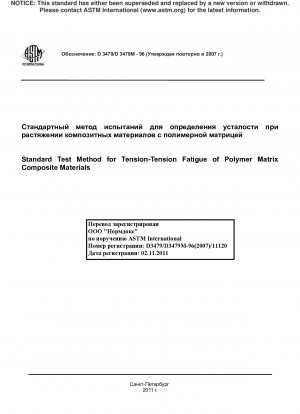ASTM D3479/D3479M-96(2007)
Standard Test Method for Tension-Tension Fatigue of Polymer Matrix Composite Materials
- Standard No.
- ASTM D3479/D3479M-96(2007)
- Release Date
- 1996
- Published By
- American Society for Testing and Materials (ASTM)
- Status
- Replace By
- ASTM D3479/D3479M-12
- Latest
- ASTM D3479/D3479M-19(2023)
- Scope
This test method is designed to yield tensile fatigue data for material specifications, research and development, quality assurance, and structural design and analysis. The primary test result is the fatigue life of the test specimen under a specific loading and environmental condition. Replicate tests may be used to obtain a distribution of fatigue life for specific material types, laminate stacking sequences, environments, and loading conditions. Guidance in statistical analysis of fatigue life data, such as determination of linearized stress life (S-N) or strain-life (ε-N) curves, can be found in Practice E 739
. This test method can be utilized in the study of fatigue damage in a polymer matrix composite such as the occurrence of microscopic cracks, fiber fractures, or delaminations.3 The specimenrsquo; residual strength or stiffness, or both, may change due to these damage mechanisms. The loss in stiffness may be quantified by discontinuing cyclic loading at selected cycle intervals to obtain the quasi-static axial stress-strain curve using modulus determination procedures found in Test Method D 3039
/D 3039M. The loss in strength associated with fatigue damage may be determined by discontinuing cyclic loading to obtain the static strength using Test Method D 3039 /D 3039M. Note 18212;This test method may be used as a guide to conduct tension-tension variable amplitude loading. This information can be useful in the understanding of fatigue behavior of composite structures under spectrum loading conditions, but is not covered in this test method..
1.1 This test method determines the fatigue behavior of polymer matrix composite materials subjected to tensile cyclic loading. The composite material forms are limited to continuous-fiber or discontinuous-fiber reinforced composites for which the elastic properties are specially orthotropic with respect to the test direction. This test method is limited to unnotched test specimens subjected to constant amplitude uniaxial in-plane loading where the loading is defined in terms of a test control parameter.
1.2 This test method presents two procedures where each defines a different test control parameter.
1.2.1 Procedure A - A system in which the test control parameter is the load (stress) and the machine is controlled so that the test specimen is subjected to repetitive constant amplitude load cycles. In this procedure, the test control parameter may be described using either engineering stress or applied load as a constant amplitude fatigue variable.
1.2.2 Procedure B - A system in which the test control parameter is the strain in the loading direction and the machine is controlled so that the test specimen is subjected to repetitive constant amplitude strain cycles. In this procedure, the test control parameter may be described using engineering strain in the loading direction as a constant amplitude fatigue variable.
1.3 The values stated in either SI units or inch-pound units are to be regarded separately as standard. Within the text the inch-pound units are shown in brackets. The values stated in each system are not exact equivalents; therefore, each system must be used independently of the other. Combining values from the two systems may result in non-conformance with this standard.
This standard does not purport to address all of the safety concerns, if any, associated with its use. It is the responsibility of the user of this standard to establish appropriate safety and health practices and determine the applicability of regulatory limitations prior to use.
ASTM D3479/D3479M-96(2007) Referenced Document
- ASTM D3878 Standard Terminology Composite Materials*, 2001-09-10 Update
- ASTM D5229/D5229M Standard Test Method for Moisture Absorption Properties and Equilibrium Conditioning of Polymer Matrix Composite Materials
- ASTM D883 Standard Terminology Relating to Plastics*, 2024-02-01 Update
- ASTM E1012 Standard Practice for Verification of Specimen Alignment Under Tensile Loading*, 1999-04-19 Update
- ASTM E122 Standard Practice for Calculating Sample Size to Estimate, With a Specified Tolerable Error, the Average for Characteristic of a Lot or Process*, 2000-10-10 Update
- ASTM E177 Standard Practice for Use of the Terms Precision and Bias in ASTM Test Methods
- ASTM E1823 Standard Terminology Relating to Fatigue and Fracture Testing*, 1997-02-10 Update
- ASTM E4 Standard Practices for Force Verification of Testing Machines*, 1999-04-19 Update
- ASTM E456 Standard Terminology for Relating to Quality and Statistics
- ASTM E467 Standard Practice for Verification of Constant Amplitude Dynamic Forces in an Axial Fatigue Testing System*, 1998-04-19 Update
- ASTM E6 Standard Terminology Relating to Methods of Mechanical Testing*, 1999-04-19 Update
- ASTM E739 Standard Practice for Statistical Analysis of Linear or Linearized Stress-Life (
S-N ) and Strain-Life (949;-N ) Fatigue Data - ASTM E83 Standard Practice for Verification and Classification of Extensometer*, 1998-01-01 Update
ASTM D3479/D3479M-96(2007) history
- 2023 ASTM D3479/D3479M-19(2023) Standard Test Method for Tension-Tension Fatigue of Polymer Matrix Composite Materials
- 2019 ASTM D3479/D3479M-19 Standard Test Method for Tension-Tension Fatigue of Polymer Matrix Composite Materials
- 2012 ASTM D3479/D3479M-12 Standard Test Method for Tension-Tension Fatigue of Polymer Matrix Composite Materials
- 1996 ASTM D3479/D3479M-96(2007) Standard Test Method for Tension-Tension Fatigue of Polymer Matrix Composite Materials
- 1996 ASTM D3479/D3479M-96(2002)e1 Standard Test Method for Tension-Tension Fatigue of Polymer Matrix Composite Materials
- 1996 ASTM D3479/D3479M-96 Standard Test Method for Tension-Tension Fatigue of Polymer Matrix Composite Materials
